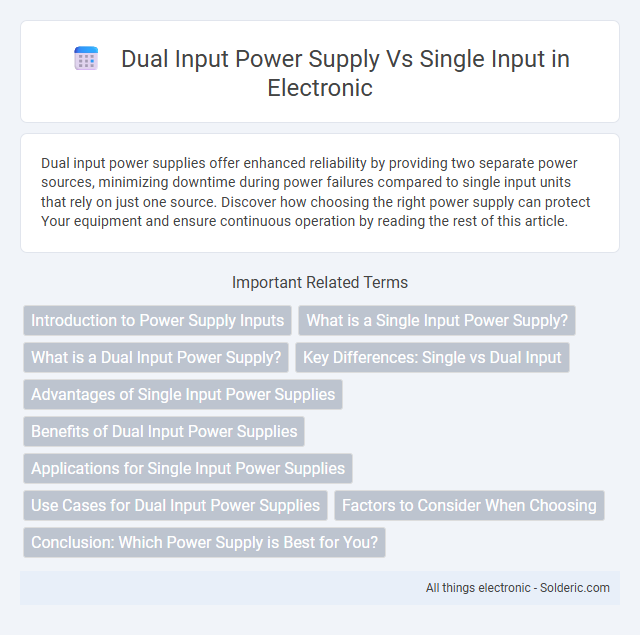Dual input power supplies offer enhanced reliability by providing two separate power sources, minimizing downtime during power failures compared to single input units that rely on just one source. Discover how choosing the right power supply can protect Your equipment and ensure continuous operation by reading the rest of this article.
Comparison Table
| Feature | Dual Input Power Supply | Single Input Power Supply |
|---|---|---|
| Power Sources | Two independent power inputs | One power input |
| Redundancy | High; Ensures continuous operation if one input fails | Low; Single point of failure |
| Reliability | Enhanced; Suitable for critical systems | Standard; Suitable for non-critical applications |
| Cost | Higher due to dual components | Lower; simpler design |
| Complexity | More complex installation and maintenance | Simple setup and maintenance |
| Use Cases | Data centers, servers, telecom equipment | Basic electronics, consumer devices |
| Failover Capability | Automatic switching between inputs | None |
Introduction to Power Supply Inputs
Dual input power supplies offer enhanced flexibility by accepting two different input voltages, typically AC and DC, enabling seamless operation across various power sources. Single input power supplies are designed to handle only one type of input voltage, which limits their application in environments with fluctuating power conditions. If your setup requires adaptability and reliability in diverse power scenarios, a dual input power supply can significantly improve system performance and reduce downtime.
What is a Single Input Power Supply?
A single input power supply accepts power from one source, typically a fixed voltage such as 120V AC or 12V DC, to convert and regulate it for electronic devices. It is designed for simple applications where only one power source is required, providing consistent and reliable output voltage. Compared to dual input power supplies, single input models have less complexity and lower cost but lack redundancy and flexibility in power sourcing.
What is a Dual Input Power Supply?
A dual input power supply is an electrical device designed to accept two separate power sources, such as AC mains and a backup DC input, ensuring continuous operation during power interruptions. This configuration enhances system reliability and allows seamless switching between inputs without downtime. Your equipment benefits from increased resilience and flexibility with a dual input power supply compared to a single input model.
Key Differences: Single vs Dual Input
Dual input power supplies offer greater redundancy compared to single input models by supporting two independent power sources, enhancing reliability in critical applications. Single input power supplies rely on one power source, which can be a single point of failure, whereas dual input units allow seamless switching between inputs to maintain continuous operation. Your choice between single and dual input should consider system reliability needs and the complexity of power infrastructure.
Advantages of Single Input Power Supplies
Single input power supplies offer simplified installation and reduced wiring complexity, which lowers overall system costs. They are generally more compact and lightweight, making them ideal for applications with limited space. Your choice of a single input power supply ensures efficient power delivery with fewer points of failure, enhancing reliability in stable environments.
Benefits of Dual Input Power Supplies
Dual input power supplies enhance system reliability by providing seamless switching between two independent power sources, ensuring uninterrupted operation during power failures. They optimize energy management and reduce downtime in critical applications by allowing automatic or manual load transfer. Your equipment benefits from increased resilience and continuous power availability, essential in industrial, medical, and telecom sectors.
Applications for Single Input Power Supplies
Single input power supplies are commonly used in applications where a stable, consistent voltage from one source is sufficient, such as in consumer electronics, small appliances, and LED lighting systems. These power supplies provide reliable energy conversion with minimal complexity, making them ideal for budget-sensitive or space-constrained environments. Your choice of a single input power supply is suitable when there is no requirement for redundancy or backup power.
Use Cases for Dual Input Power Supplies
Dual input power supplies are essential for critical applications requiring uninterrupted power, such as medical devices, industrial automation, and data center equipment. Their ability to seamlessly switch between two power sources ensures reliability and reduces downtime, protecting sensitive components from power failures. Your system benefits from enhanced operational stability by incorporating these power supplies in environments with fluctuating power availability.
Factors to Consider When Choosing
Selecting between a dual input power supply and a single input model depends on factors such as redundancy requirements, input voltage flexibility, and system reliability. Dual input power supplies offer enhanced fault tolerance with the ability to switch between two independent power sources, making them ideal for critical applications. Single input power supplies may suffice for less critical systems, prioritizing cost efficiency and simpler design where backup power is not mandatory.
Conclusion: Which Power Supply is Best for You?
Dual input power supplies offer enhanced flexibility and redundancy by supporting multiple voltage sources, making them ideal for critical applications requiring high reliability. Single input power supplies are simpler, more cost-effective, and suitable for stable environments with consistent power availability. Your choice depends on the importance of uninterrupted power versus budget constraints and complexity.
dual input power supply vs single input Infographic

 solderic.com
solderic.com